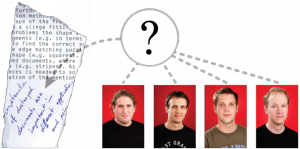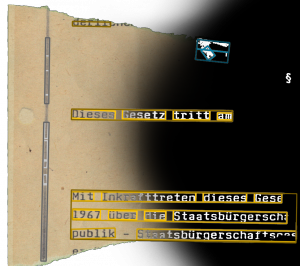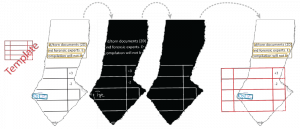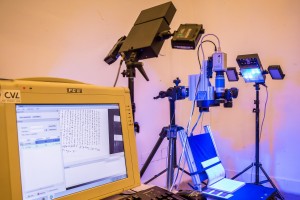On the one hand, the Computer Vision Lab deals with the acquisition and enhancement of ancient manuscripts. This involves philological image analysis which aims at the examination of the formal peculiarities of the scripts (palaeographic side) and the form- and function relationship of the writing systems (graphemic side). On the other hand, it concentrates on the reconstruction of destroyed documents having cultural and historic value. This is done by an automated computation of layout, text and content features in single fragments.
Text Classification and Writer Identification
Text Classification allows to distinguish handwritten text from printed text. The result of the classification can be used to apply different character recognition algorithms according to the mentioned problem (handwritten vs. printed). Writer Identification has the goal to assign different documents to the according hands (writers). The classification of different writers can be used in the forensics or for the reconstruction of destroyed documents
Segmentation
Binarization is the identification of connected regions (e.g. letters) according to homogeneous gray levels. The result of the binarization is a black/white image describing the foreground (e.g. white pixels) and the background (e.g. black pixels). In document analysis this is a preprocessing step for Optical Character Recognition (OCR). The accuracy of the binarization influences all following document processing algorithm based on segmentation. Challenges are degraded documents (e.g. ancient manuscripts) with a low contrast and distortions (fading out of ink, …).
Layout Analysis
Layout analysis determines regions within a page. As a result text regions (paragraphs), images and drawings are classified. As a result an automated workflow of scanned documents can be applied (for e.g. transcriptions, OCR in text regions), which is needed if a large amount of documents is digitized (e.g. in libraries). In addition forms can be classified and filled out cells can be recognized for an automated evaluation.
Multispectral Imaging
Digital imaging for ancient documents has gained significant interest in recent years. It opens new possibilities in analyzing, preserving and presenting the content of our cultural heritage. Using multispectral imaging techniques in combination with digital image processing allows on the one hand enhancing the readability of “hidden” texts (e.g. palimpsests, vanished or damaged text due to environmental effects like mold, humidity or fading out of ink) and on the other hand automated investigation of the structure and content of the manuscripts. Nondestructive methods like InfraRed (IR) reflectography are used by multispectral imaging systems to visualize palimpsests or underdrawings. Additionally UltraViolet (UV) fluorescence techniques are used to enhance the readability of palimpsests. A palimpsest is a page of a manuscript that has been written on, scraped off and used again.




